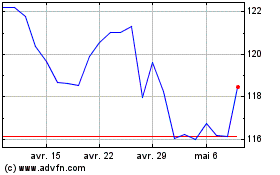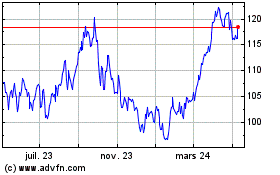Celebrating 25 Years of Santoprene TPEs; ExxonMobil Chemical's Elastic Plastic Serves Thousands of CustomersThere are currently
27 Juin 2006 - 9:05PM
Business Wire
Research to create a new material for an injection-molded tire
resulted in the commercialization of Santoprene(TM) thermoplastic
elastomer (TPE) 25 years ago. Today, the Santoprene product
portfolio has over 300 grades that are used by thousands of
customers across the globe in the automotive, food and beverage,
consumer electronics, electrical, and appliance markets. This
resourceful, innovative and committed pioneer continues to be
recognized today as the global leader in engineered TPEs. This
article celebrating 25 years of Santoprene brand TPEs charts the
development of the brand from the obstacles it faced to the
successes it enjoys with an outlook toward continued growth.
Overcoming early hurdles The unique material that became Santoprene
TPE exhibited the performance characteristics of rubber and the
processing ease of a plastic, with complementary benefits. But it
was not an overnight success. "Initially we targeted the processors
that manufactured finished parts from rubber," said Bob Liskiewicz,
global sales manager for ExxonMobil Chemical's Specialty Elastomers
Business. "The new material got a luke-warm reception from the
rubber industry. Target customers weren't prepared to work with a
material that was fully compounded or invest in the new equipment
they needed to process it. We were excited about the opportunities
of the material, but the rubber industry was reluctant to invest in
a new business." A revised business strategy focused on the
customers of the rubber processors. Approaching automotive original
equipment manufacturers (OEMs) and appliance manufacturers proved
successful. "We convinced them that we had an interesting new
material. Now we had to encourage the creation of a supply chain
that could manufacture the parts," explained Liskiewicz. The clear
message that got the interest of the OEMs was cost savings.
Santoprene TPEs' faster part-production cycle times, lower weight
and ease of production all contributed to lower part costs. "We
established Rubber Conversion Economics, which compared every
aspect of producing a part in a traditional rubber material with
Santoprene TPE. We demonstrated that an OEM could save a
significant percentage on the cost of the final part if they
converted to our TPE," said Liskiewicz. In addition to cost
savings, the establishment of unrivalled technical support
capabilities and the manufacturing capabilities to provide
materials of consistent quality across the world led to a
successful global business. Early successes The brand achieved an
important early application success in the automotive sector. While
the rack-and-pinion boot only costs a small percentage of the
steering system to manufacture, it plays a critical role in
protecting the system. The ability of Santoprene TPE to improve
flex life, fluid resistance and sealability of the boot is key to
the success of this application. The reduction in manufacturing
costs is an added bonus. "The application has been so successful
that it can probably be found in four out of five cars on the road
today," explained Liskiewicz. In the appliance sector, the business
worked with OEMs to manufacture components -- often seals -- for
household appliances such as dishwashers and washing machines. A
dishwasher sump boot made with Santoprene TPE was an early success
as it was installed in many major brands and models. Again the
functional benefits of Santoprene TPE -- good sealing and
resistance to heat and fluids -- were important. The elastomer's
sealing capabilities also led to early successes in the domestic
and high-rise construction sectors in applications such as window
seals, caster wheels, tubing and small hose parts, electrical
connectors and coatings for wire & cables. Santoprene TPE also
found success in the highly demanding medical industry where it is
used as a gasket on syringe plungers. Sound strategies At the
outset, the business implemented an astute intellectual property
strategy that extended Santoprene products' commercial longevity as
competitive products entered the market. As these products became
available, the strong brand values that were established and built
from the earliest days demonstrated that it takes more than
products to help make customers successful in rubber replacement
and other TPE applications. Combining performance improvements and
cost reductions with the best global support in the industry --
logistics, inventory in-hand, 24-48 hour delivery, consistent
quality and extensive technical support -- have all become key
components in the success of the business. It established a 98
percent on-time delivery rate for customers from Boston to
Barcelona to Beijing. "We serve thousands of customers with an
extra special level of service day after day," added Liskiewicz. As
the business worked with OEMs, it started to bring work to
processors, creating a strong loyalty among them. "We collaborate
and dedicate resources to companies often before they are
customers. Whether it's market knowledge, design assistance or
supply chain expertise, we bring all our experience to bear to help
companies design, develop and introduce new products to market. We
offer the immediate technical and design support of our engineering
specialists through web conferencing, online collaboration, our
AnswerPerson(TM) service and face-to-face," said Liskiewicz. "As a
result, we have achieved double-digit growth in volume and sales
for most of the past 25 years." As another demonstration of its
commitment to the industries it serves, the Santoprene specialty
products business is certified to the same standards as some of its
customers and their customers. For example, it recently achieved
certification to the globally accepted automotive industry quality
standard ISO/TS 16949:2002. Continued growth The business expanded
in the mid 1990s when it began to promote the use of Santoprene TPE
to enhance the way products look or how they feel to the touch.
This "soft-touch" concept enabled the business to develop extensive
use of Santoprene elastomers in grips for consumer products such as
ski poles, gardening and power tools, razors, toothbrushes and
pens. The business worked with product designers who began to use
Santoprene TPE for the aesthetic effects it produces -- soft touch,
color, texture and special effects. "This extra dimension opened up
the consumer market for us," said Liskiewicz. In the late 1990s,
the business developed new opportunities in the automotive industry
by proving to automotive OEMs that TPEs were a viable alternative
to thermoset rubber for sealing systems. Today, automotive OEMs
fully recognize and embrace the opportunities for improved
performance, weight reductions that boost fuel efficiency, and
parts cost savings that are achieved using Santoprene TPE. The use
of Santoprene TPE also enables soft/hard material combinations,
depending on the performance requirements of each part of the seal.
Other automotive OEMs have come to appreciate the benefits of
changing to TPEs. An exciting future "Looking forward we see
potential for growth in developing countries, new applications,
product development and modular systems," said Liskiewicz. China
and other countries in Asia, Central Europe and Latin America
represent growth markets. The Santoprene brand is established in
Japan through commercial links with major OEMs in the automotive
sector. Establishing a presence in China and helping a customer
there create a first commercial success with Santoprene TPE 20
years ago, the business is ideally positioned to benefit from this
rapidly evolving market. New applications will continue to drive
growth. Many of the consumer markets are only just starting to
truly appreciate the benefits of Santoprene products and there are
still excellent growth opportunities in the automotive sector. New
products are in development as the business researches compounds or
hybrids of TPEs and TPVs to match target performance requirements.
New Santoprene TPE bonding grades maximize the potential of
overmolding technology to eliminate the need for adhesives and
mechanical interlocks to combine different materials. As part of
ExxonMobil Chemical's Specialty Elastomers Business, there is also
a broad portfolio of elastomer products on which to draw. This has
recently led to the adoption of a modular approach where the
performance requirements of a whole system, such as a car door
system, are being considered and solutions proposed. "Without
doubt, the underlying success of the business has been a singular
focus on the customer, delivered by exceptional people with an
inquiring and responsive attitude. Adding value to a customer's
product helps them bring value to their customers. This is, and
always will be, at the core of the development and growth of the
Santoprene brand," concluded Liskiewicz. About ExxonMobil Chemical
ExxonMobil Chemical is a global leader in technology, product
quality and customer service with petrochemical manufacturing
and/or marketing operations in more than 150 countries around the
world. Its products include olefins, aromatics, fluids, synthetic
rubber, polyethylene, polypropylene, oriented polypropylene
packaging films, plasticizers and synthetic lubricant basestocks.
To find out more about ExxonMobil Chemical's Santoprene rubber,
visit www.santoprene.com. To find out more about ExxonMobil
Chemical, visit www.exxonmobilchemical.com. Note to Editors: 1. The
term "ExxonMobil Chemical" refers collectively to some or all of
the companies affiliated with Exxon Mobil Corporation which have
chemical manufacturing and/or marketing operations around the
world. 2. ExxonMobil, the ExxonMobil logo, the "Interlocking X" and
Santoprene are trademarks or registered trademarks of Exxon Mobil
Corporation.
Exxon Mobil (NYSE:XOM)
Graphique Historique de l'Action
De Juin 2024 à Juil 2024

Exxon Mobil (NYSE:XOM)
Graphique Historique de l'Action
De Juil 2023 à Juil 2024
